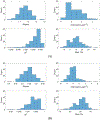Development of a calibration chamber to evaluate the performance of low-cost particulate matter sensors
- PMID: 31521992
- PMCID: PMC7409587
- DOI: 10.1016/j.envpol.2019.113131
Development of a calibration chamber to evaluate the performance of low-cost particulate matter sensors
Abstract
Low-cost particulate matter (PM) air quality sensors are becoming widely available and are being increasingly deployed in ambient and home/workplace environments due to their low cost, compactness, and ability to provide more highly resolved spatiotemporal PM concentrations. However, the PM data from these sensors are often of questionable quality, and the sensors need to be characterized individually for the environmental conditions under which they will be making measurements. In this study, we designed and assessed a cost-effective (∼$700) calibration chamber capable of continuously providing a uniform PM concentration simultaneously to multiple low-cost PM sensors and robust calibration relationships that are independent of sensor position. The chamber was designed and evaluated with a Computational Fluid Dynamics (CFD) model and a rigorous experimental protocol. We then used this new chamber to calibrate 242 Plantower PMS 3003 sensors from two production lots (Batches I and II) with two aerosol types: ammonium nitrate (for Batches I and II) and alumina oxide (for Batch I). Our CFD models and experiments demonstrated that the chamber is capable of providing uniform PM concentration to 8 PM sensors at once within 6% error and with excellent reliability (intraclass correlation coefficient > 0.771). The study identified two malfunctioning sensors and showed that the remaining sensors had high linear correlations with a DustTrak monitor that was calibrated for each aerosol type (R2 > 0.978). Finally, the results revealed statistically significant differences between the responses of Batches I and II sensors to the same aerosol (P-value<0.001) and the Batch I sensors to the two different aerosol types (P-value<0.001). This chamber design and evaluation protocol can provide a useful tool for those interested in systematic laboratory characterization of low-cost PM sensors.
Keywords: Air quality; Calibration chamber; Evaluation of calibration chamber; Low-cost sensors; Particulate matter.
Copyright © 2019 Elsevier Ltd. All rights reserved.
Conflict of interest statement
COI statement:
Drs. K. Kelly and P.-E. Gaillardon have an interest in the company Tetrad: Sensor Network Solutions, LCC, which commercializes solutions for environmental monitoring.
Regards,
Tofigh Sayahi
PhD candidate in Chemical Engineering
University of Utah
Figures




References
-
- Ali H, Soe JK, Weller SR, 2015. A real-time ambient air quality monitoring wireless sensor network for schools in smart cities. 2015 IEEE 1st Int. Smart Cities Conf. ISC2 2015 5–10. doi:10.1109/ISC2.2015.7366163 - DOI
-
- ANSYS, 2019. ANSYS FLUENT 12.0 User’s Guide - 7.3.2 Using Flow Boundary Conditions [WWW Document]. URL http://www.afs.enea.it/project/neptunius/docs/fluent/html/ug/node238.htm (accessed 4.30.19).
-
- Apte JS, Brauer M, Cohen AJ, Ezzati M, Pope CA, 2018. Ambient PM2.5Reduces Global and Regional Life Expectancy. Environ. Sci. Technol. Lett. 5, 546–551. doi :10.1021/acs.estlett.8b00360 - DOI
-
- Arvind DK, Mann J, Bates A, Kotsev K, 2016. The AirSpeck Family of Static and Mobile Wireless Air Quality Monitors. Proc. - 19th Euromicro Conf. Digit. Syst. Des. DSD 2016 207–214. doi:10.1109/DSD.2016.110 - DOI
MeSH terms
Substances
Grants and funding
LinkOut - more resources
Full Text Sources
Medical
Miscellaneous

